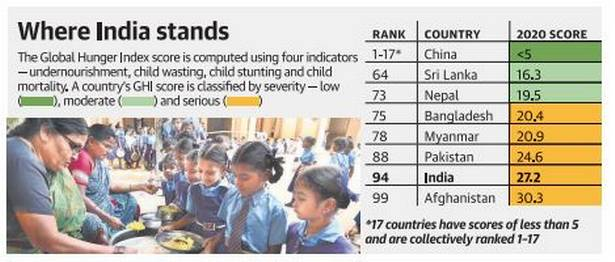India’s low rank on nutritional index
About global hunger index
- The Global Hunger Index is an annual score ranking countries of the world on hunger levels.
- It is prepared by NGO Welthungerhilfe and Concern Worldwide.
- It is based on 4 indicators:
- Undernourishment- Share of the population with insufficient caloric intake.
- Child wasting – The share of children under the age of five who have low weight for their height, reflecting acute undernutrition
- Child stunting – children under the age of five who have low height for their age, reflecting chronic undernutrition
- Child mortality – the mortality rate of children under the age of five.
- Based on the values of the four indicators, the GHI determines hunger on a 100-point scale where 0 is the best possible score (no hunger) and 100 is the worst.
Highlights of Global Hunger Index 2020
- India has been ranked at 94 among 107 countries in the Global Hunger Index (GHI) 2020
Which secures 102nd rank out of 117 countries in the 2019 index report.
- The country’s score of 27.2 is the worst among BRICS countries, and inferior to Pakistan, Sri Lanka, Bangladesh and Nepal.
- India has the highest prevalence of wasted children under five years in the world, which reflects acute undernutrition.
- Child stunting has actually improved significantly, from 54% in 2000 to less than 35% now.
- Child wasting, on the other hand, has not improved in the last two decades, and is rather worse than it was decades ago.
- India has improved in both child mortality rates and undernourishment, with about 14% of the total population which gets an insufficient caloric intake.
- In the region of south, east and south-eastern Asia, the only countries which fare worse than India are Timor-Leste, Afghanistan and North Korea.

Current scenario
- According to the International Food Policy Research Institute three out of four rural Indians cannot afford a balanced, nutritious diet.
- Globally, nearly 690 million people are undernourished which warns that the COVID-19 pandemic could have affected the progress made on reducing hunger and poverty.
- The world is not on track to achieve the second Sustainable Development Goal – known as Zero Hunger for short – by 2030.
Way forward
- National policy should call for a radical transformation in the delivery of adequate nutrition especially to women and children, and pay adequate attention to achieving diet diversity through the PDS.
- Strengthening the PDS, with a focus on women’s health, would lead to healthier pregnancies, and stronger supplemental nutrition under the ICDS scheme would give children a better chance at all-round development.
- Necessary measures to be taken to bring the true benefits of the National Food Security Act to the unreached, not merely as hunger mitigation through cereals, but as nourishment through a diverse diet that includes fat, protein and micronutrients.
- The right to food would be meaningless if it leaves a large section of Indians hungry, stunted and wasted.
References:
Subscribe
Login
0 Comments
